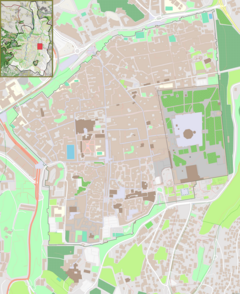This is an old revision of this page, as edited by Dr. Blofeld (talk | contribs) at 21:29, 28 February 2011 (add infobox and map). The present address (URL) is a permanent link to this revision, which may differ significantly from the current revision.
Revision as of 21:29, 28 February 2011 by Dr. Blofeld (talk | contribs) (add infobox and map)(diff) ← Previous revision | Latest revision (diff) | Newer revision → (diff)| Zion Gate | |
|---|---|
 Zion Gate Zion Gate | |
 | |
| General information | |
| Town or city | Jerusalem |
| Country | Israel |
Zion Gate (Template:Lang-he, Shaar Zion, Template:Lang-ar, Bab an-Nabi Dawud) is one of eight gates in the walls of the Old City of Jerusalem.
History
Located in the south of the Old City, facing Mount Zion and Hebron, the Zion Gate leads into the Armenian and Jewish Quarters. Zion Gate is also known as David's Gate (Template:Lang-ar; Template:Lang-he), because the tomb of King David is believed to be on Mt. Zion. The gate was built for Suleiman the Magnificent in 1540. In the 19th century, an area close to the gate was the gathering place of lepers.

In the 1948 Arab-Israeli War, the Palmach gained control of the Jewish Quarter via the Zion Gate. The stones surrounding the gate were pockmarked by weapons fire and bullet holes that are still visible today. The last British troops leaving Jerusalem on May 13, 1948, presented Mordechai Weingarten with the key to the gate. The gate was under the rule of Jordan until the Six-Day War.
Both pedestrians and vehicles use the gate, although maneuvering is difficult due to the L-shaped passageway. Until recently, there was two-way vehicular traffic passing through the gate. Today cars can exit but not enter the Old City via this gate.
References
- Steckoll, Solomon H., "The Gates of Jerusalem". Published by George Allen and Unwin Ltd, London. 1968. Copyright Am Hassefer Publishers Ltd. Tel Aviv. Page 39.
31°46′22.3″N 35°13′45.7″E / 31.772861°N 35.229361°E / 31.772861; 35.229361
Categories: